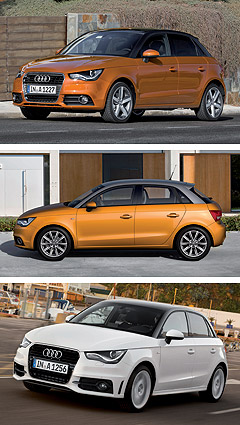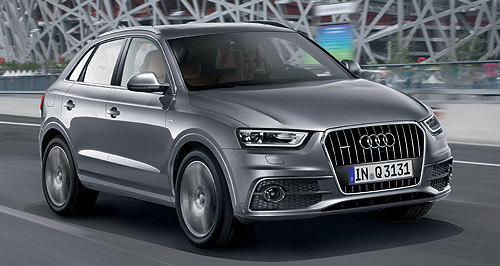Future models - Audi - Q3Audi looks to small vehicles for big thingsNew entrant: The Audi Q3 compact SUV - based on the VW Golf platform - will arrive Down Under later this month. Q3 and A1 Sportback set to provide launching pad for Audi growth in Australia1 Mar 2012 THE two smallest vehicles to be launched by German luxury brand Audi in Australia this year are expected to have the biggest impact on the ambitious company’s sales aspirations, not just in immediate volumes but long term. Audi Australia believes the Q3 premium compact SUV and the five-door Sportback version of the baby A1 will provide immediate conquest business while also doubling as a future springboard for customers to step up the model range into bigger vehicles such as the Q5, A3 and beyond. The Golf-based Q3 is due later this month, becoming Audi’s first entrant in the burgeoning compact SUV segment, while the A1 Sportback will join the original three-door A1 in showrooms about June. These models are just two of about 14 new or facelifted Audi products due to land in Australia this year, starting with the A5 facelift launched this week and capped by the flagship S8 super-saloon in the final quarter. Along the way, the company will wheel out the facelifted A4, A4 Allroad, new S6, S7 Sportback, facelifted RS5, R8 GT Spyder and TT S-Tronic, among others. Audi Australia managing director Uwe Hagen told GoAuto that he regarded the Q3 and A1 Sportback as the most important launches because of their potential to generate new business.  Left: Audi A1 Sportback. Left: Audi A1 Sportback.“The Q3, which is already launched in other markets, has seen massive demand all over, and it is coming with a huge conquest,” he said. “This will be one major launch, the other will be the A1 Sportback. “Because we are working on customer loyalty, there is a good chance we can keep the customer and develop him into further segments.” Mr Hagen pointed to the 24 per cent growth in SUV sales in Australia last year as one reason why he was confident the Q3 would quickly find its feet. Audi itself enjoyed 19 per cent SUV sales growth last year, selling 4144 Q5s and Q7s, with the Q5 outselling BMW’s best-selling SUV, the X5. The new Q3 – made in Spain and powered by a choice of 2.0-litre petrol and diesel four-cylinder engines – will go head-to-head with one of BMW’s most successful newcomers, the X1. Last year, the X1 achieved 2266 sales in its first year, outselling its one-size-larger X3 sibling (2103 units). Mr Hagen was reluctant to be drawn on which of the three German luxury car companies would come out on top in overall sales this year, saying only that Audi still had its sights set on number-one spot by 2015. “What I can see is that all three competitors are getting really close,” he said. “Each one is offering basically the same things. Every competitor has a form of an advantage within the launch year where they have their volume cars. “You catch attraction with new models, but the volume section is the major thing. BMW just launched the 3 Series, and I think they will take advantage this year. “We will launch our products within the next year, and we will take our advantage. “It is really a bit like a relay team – everyone has his specific period where he carries his little stick, and the focus goes to him, but at the same time we are all running around the same.” Last year, BMW’s 17,508 sales eclipsed the 2010 winner Mercedes-Benz (16,870) in the head-to-head SUV/passenger car calculation (disregarding commercial vehicles that BMW does not sell), with Audi in third place (14,511). The arrival of the all-important new BMW 3 Series is expected to seal another victory to the Munich brand this year. Mr Hagen agreed that Audi was likely to surpass 15,000 units this year, achieving the one-time 2015 sales target under its Route 15 mid-term plan, three years early. He said that target had been set when 15,000 seemed like a ceiling for the luxury car brands in Australia, but now the sales goal was simply to be number one. “Our competitors are not waiting, so it is a little bit flexible,” he said. “We have to see what the market will deliver.” Despite Audi’s spiralling growth over the past several years, Mr Hagen described the current selling environment as tough. In January, Audi suffered a rare sales retreat, with retails down 9.7 per cent, mainly due to slipping sales of the A5 and A4 ranges, both of which are being facelifted. The revised A5 was launched last week and the A4 is due in April. Mr Hagen said he was not concerned with the drop-off of A4 sales in the past year, saying it was due to two reasons – an end-of-model cyclical drop-off and competition from within Audi’s own range from new models such as the A5 and Q5. He said he still regarded the A4 as a core Audi model, but that Audi could do better if Australians warmed more to station wagons such as the A4 Avant.  Read more11th of January 2012  Detroit show: Q3’s Winter wonderlandAudi previews forthcoming compact SUV with glitzy Q3 Vail conceptQ3 pricing
Motor industry news |
Click to shareAudi modelsResearch Audi Q3 pricing
Motor industry news |
















Facebook Twitter Instagram